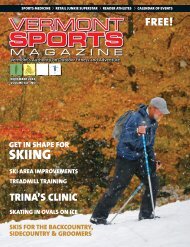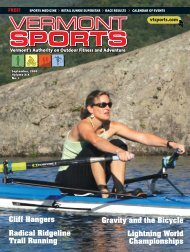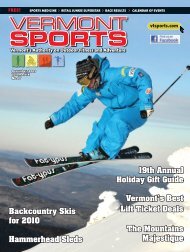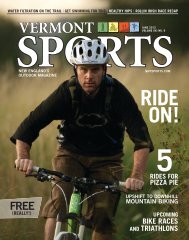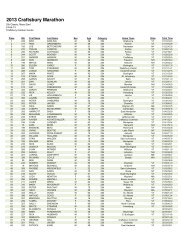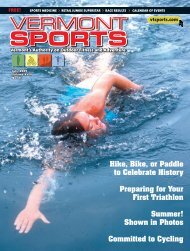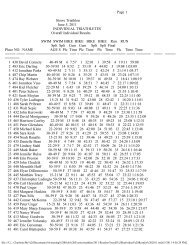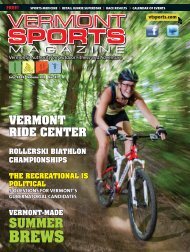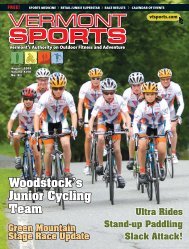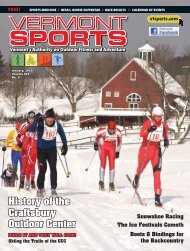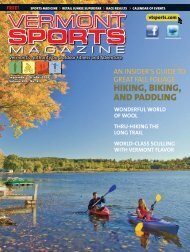Vermont Sports Magazine
Vermont Sports Magazine
Vermont Sports Magazine
Create successful ePaper yourself
Turn your PDF publications into a flip-book with our unique Google optimized e-Paper software.
HOW TO FAKE A CENTURY RIDE<br />
RETAIL JUNKIE<br />
SUPERSTAR<br />
BY<br />
RYAN JAMES LECLERC<br />
For the first time since I co-founded it<br />
eight years ago, I rode in our shop’s<br />
annual century ride, a 111-mile bicycle<br />
ride designed to financially benefit<br />
the library while physically exhausting<br />
the ride participants. It has been a personal<br />
goal of mine to do the ride since that<br />
inaugural year, but I never could because<br />
being an organizer, I needed to organize it.<br />
When I handed over the reins four years<br />
ago to Scarrie, the current organizer, I either<br />
needed to help her organize it or attend<br />
a wedding that fell on the same day.<br />
This year, I didn’t need to organize it, I<br />
didn’t need to help organize it, and I didn’t<br />
need to attend a wedding; so for the first<br />
time in eight years, I didn’t have an excuse<br />
for not riding it, so I rode it. Of course, in<br />
the eight years since that first ride, my<br />
legs were as hairy as they’ve ever been,<br />
and I was in the worst riding shape of my<br />
life, but I did the ride anyway, and finished<br />
it in a respectable 5 hours and 24 minutes,<br />
using a little tactic known as faking it.<br />
Faking a century is different from<br />
simply riding a century, which any cyclist<br />
can do. Faking it is when you finish<br />
the ride with an average pace that is well<br />
above what you normally can maintain<br />
without falling over. When I crossed the<br />
finish line, the average speed on my computer<br />
read 20 mph, and I was able to get<br />
off my bike and remain upright. On any<br />
other ride, if I managed to maintain an<br />
average pace of 18 mph, I would only have<br />
to assume that someone, perhaps the CIA,<br />
spiked the herbal tea I drank the night before<br />
with beer and whiskey, elevating my<br />
testosterone to unnatural levels.<br />
So how does one fake a century ride?<br />
By following my training plan and a few<br />
simple rules, which I will now describe. My<br />
sincerest apologies to all the true athletes<br />
out there.<br />
RULE #1: You need to train, but not<br />
really. There is no way around the fact<br />
“Faking a century<br />
is different from<br />
simply riding a<br />
century, which<br />
any cyclist can do.<br />
that to fake a century, you need to put<br />
a few miles on your legs. But my training<br />
doesn’t need to require hitting 1,000<br />
miles before the snow melts, maintaining<br />
a training log, drinking raw egg shakes,<br />
suffering through interval workouts and<br />
hill repeats, or cutting back on beer. You<br />
just need to put on a decent amount of<br />
miles on your legs—about 500 should suffice—which<br />
if you start riding in April, can<br />
easily be achieved with a couple 30- to 40-<br />
mile rides per week. As well, you need to<br />
do a few “longer” rides, which I consider to<br />
be in the 50- to 60-mile range. This is just<br />
enough riding to get the minimum amount<br />
of fitness in your legs so that you can keep<br />
the pedals turning for five to six hours.<br />
More important, it provides just enough<br />
conditioning that your back, neck, and<br />
especially your bottom will not surrender<br />
halfway through the ride. If, however, the<br />
only training rides you’ve done consist of<br />
half-mile round trips to the bar on a cruiser<br />
bike, and the only “longer” rides you’ve<br />
done consist of three-mile rides to the beer<br />
store because the bar wasn’t open yet,<br />
you’ll suffer like you’ve never known, and<br />
then you’ll bonk.<br />
For those of you who have never bonked,<br />
or “cracked” as some call it, imagine<br />
the most exhausted, hungry, uncomfortable,<br />
and miserable you’ve ever been,<br />
like being stuck on a grounded airplane<br />
for three hours after a 48-hour nonstop<br />
Christmas shopping spree in Las Vegas.<br />
Then imagine yourself slung over a bike<br />
on a lonely back road grinding up a steep<br />
hill that stretches for eternity, a rusty boat<br />
anchor tied to your seat post, cold rain falling<br />
down, and only a few buzzards circling<br />
overhead to keep you company.<br />
RULE #2: The night before the ride,<br />
cut back on beer. I had mentioned earlier<br />
that my training plan doesn’t require<br />
cutting back on beer, which is true with<br />
one exception: the night before the ride.<br />
You don’t have to abstain entirely, just<br />
drink a few less beers and a few more<br />
glasses of water.<br />
RULE #3: Get into a group of riders<br />
with names like Heather the Hammer,<br />
Bobby Bionic, and Andrew McKiller,<br />
and let them do all of the work. On every<br />
group ride, someone needs to be in front<br />
with their nose in the headwind, and it<br />
doesn’t need to be you. Stay in the rotation<br />
like everyone else, but when you’re about<br />
three or four riders from the front, peel off<br />
and roll to the back. Repeat this process<br />
for the duration, avoiding taking even a<br />
single, energy-sucking pull. The other<br />
riders will eventually notice what you’re<br />
up to and will refer to you as a sandbagger,<br />
but it beats falling off the train, being left<br />
for dead.<br />
RULE #4: Show up with hairy legs.<br />
This tells the other riders that you are by<br />
no means a racer or a serious roadie. It<br />
will be assumed that you will get dropped<br />
on the first big climb or at least well before<br />
the finish, so if you manage to hang in<br />
there, the riders will be surprised and<br />
maybe even a bit impressed, and they will<br />
cut you some slack for being a sandbagger.<br />
However, if you show up with shaved legs<br />
and sandbag the whole ride, you can<br />
count on a few steely glares and the silent<br />
treatment during the post-ride barbeque.<br />
There was a time when I didn’t need<br />
to fake century rides, when I was in top<br />
form and had the shaved legs to prove it.<br />
I’d love to get that form back. Maybe next<br />
year I’ll find it again, and won’t need to<br />
fake the century ride. I’ll train for real,<br />
and I’ll do the ride for real. I’ll take my<br />
share of pulls and maybe even challenge<br />
for a town-line sprint. But just to be safe,<br />
I’ll keep my legs hairy.<br />
Ryan James Leclerc used to be single and used to work on the sales floor of Onion<br />
River <strong>Sports</strong>. He is now married and works in the office of Onion River <strong>Sports</strong>. The<br />
creative license he procured in a back alley allows him to occasionally narrate from<br />
the past as though it were the present.<br />
EVOLVED,<br />
TO PERFECTION<br />
Twist-Lock<br />
HyperFlow<br />
Drink Cap<br />
100% BPA<br />
& Taste-Free<br />
Ultralight,<br />
Collapsible,<br />
Convenient<br />
The new Platy SoftBottle makes hydration<br />
easy with a twist-lock HyperFlow drink cap,<br />
and a collapsible, taste-and BPA-free design for<br />
the ultimate in on-the-go convenience. Discover<br />
the next generation of hydration at platy.com.<br />
September/October 2011 VERMONT SPORTS 19



